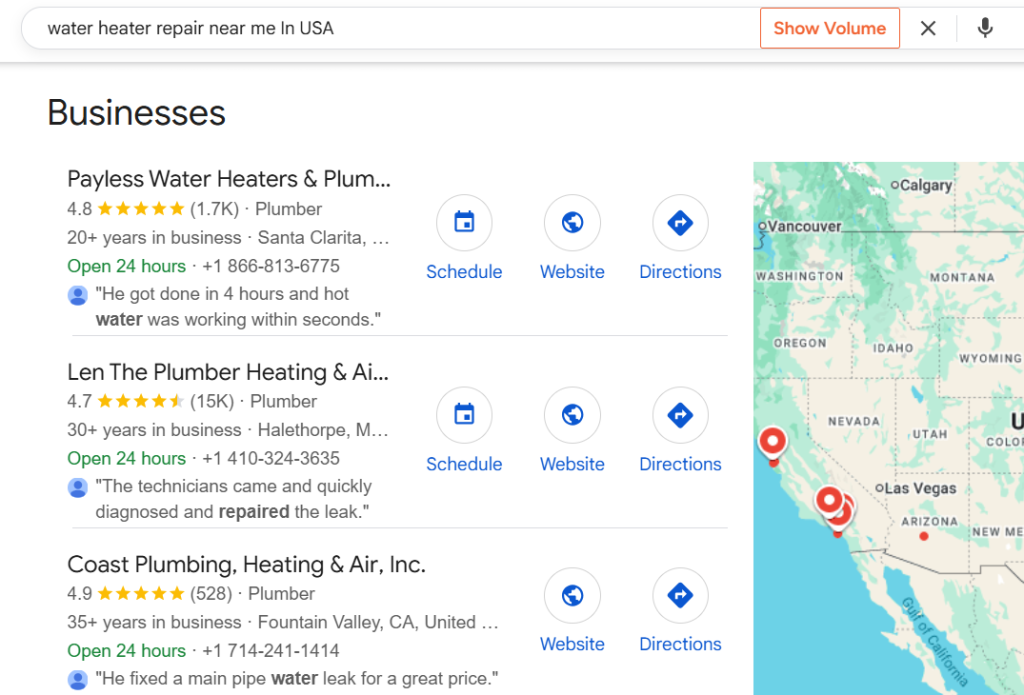The plumbing industry has always been essential, but in today’s digital-first world, the way customers find and choose plumbing services has drastically changed. Homeowners no longer flip through a phonebook or rely solely on word-of-mouth recommendations. Instead, they search on Google, scroll through Facebook, or ask for recommendations online. For plumbers, this means one thing: without a strong digital presence, your business risks being invisible to potential customers.
Digital marketing for plumbers goes far beyond running ads—it’s about establishing credibility, nurturing long-term client relationships, and creating a steady stream of leads on autopilot. With the right mix of website optimization, local SEO, online reviews, and targeted social media advertising, plumbers can differentiate themselves in an increasingly competitive market. To understand how these tactics align with broader industry trends, explore the best digital marketing strategies that can be customized to help plumbing businesses grow visibility and trust while driving consistent results.

For those starting fresh in the plumbing industry, digital marketing should be built into your entrepreneurial foundation. If you’re new to business ownership, check out this resource on how to Start a New Business to lay the groundwork before scaling with marketing strategies.
We’ll walk you through beginner-friendly tactics and advanced marketing methods, all tailored for plumbing businesses. By the end, you’ll know how to set up a powerful online presence that attracts steady leads, builds trust, and helps you compete even with the biggest service providers.
Creating a Plumber-Friendly Website
Your website is your digital storefront. It’s the first impression most customers will have of your plumbing business, and it must look professional, load quickly, and clearly explain your services.
- Key features: Mobile-friendly design, service pages (emergency plumbing, drain cleaning, water heater installation), clear contact details, and an easy “Book Now” button.
- Budget: Basic websites can cost as little as $300–$800 if built using DIY platforms, or $1,500+ for a custom design (PHP or Laravel program it will cost $1000 to $1500 max.
- Example: A plumber in USA/Canada/UK offering “24/7 emergency services” prominently on the homepage will attract late-night customers searching for immediate help.
Pro Tips: Include customer testimonials and before/after photos to build instant trust.
Google Business Profile Optimization
Your Google Business Profile (formerly Google My Business) is one of the most powerful free tools for plumbers. It ensures your business appears in local search results and Google Maps when someone searches “plumber near me.”
- Step 1: Claim your listing at business.google.com.
- Step 2: Add accurate NAP (Name, Address, Phone) information.
- Step 3: Upload photos of your team, equipment, and recent jobs.
- Step 4: Ask happy customers to leave reviews.
Benefits: Increases local visibility, helps customers call directly from search results, and builds trust with positive reviews.
Local SEO for Plumbers
Local SEO for Plumbers is essential for attracting nearby customers who are actively searching for plumbing services. By optimizing your Google Business Profile, adding location-based keywords, and encouraging customer reviews, you can rank higher in local search results. This helps potential clients find your business quickly when they need urgent plumbing solutions. A well-structured local SEO strategy not only increases visibility but also builds trust within your community. To understand the broader framework behind these strategies, explore my complete guide on Search Engine Optimization.
- Target keywords: “plumber in [your city],” “emergency plumbing [location],” “water heater repair near me.”

- Strategies:
- Add local keywords in titles, headings, and meta descriptions.
- Get listed on local directories like Yelp, Thumbtack, or United States or Canada or equivalents.
- Encourage local backlinks from suppliers or home service blogs.
Example: If someone in United States searches “pipe repair near me,” local SEO ensures your business shows up first instead of a competitor.
Content Marketing for Plumbers
Content is what makes your plumbing business look knowledgeable and trustworthy online.
- Blog posts: Write guides like “5 Signs Your Water Heater Needs Repair.”
- FAQs: Answer common questions like “Why is my drain always clogged?”
- Videos: Share quick repair tips or behind-the-scenes looks on YouTube and Facebook.
Budget: Minimal—blogs and FAQs cost time more than money. Videos may require basic equipment (camera + tripod, around $200).
Why it matters: Customers see you as an expert, leading to more calls and service requests.
SEO (Search Engine Optimization)
SEO is the backbone of digital marketing for plumbers. While local SEO focuses on your area, general SEO ensures your website is optimized for search engines.

- On-page SEO: Use plumber-related keywords, fast loading speed, optimized images, internal linking.
- Off-page SEO: Get backlinks from home improvement blogs, suppliers, or local news.
- Technical SEO: Make sure your site is secure (HTTPS), mobile-friendly, and easy to navigate.
ROI: SEO can generate free leads for years, unlike paid ads that stop once the budget ends.
Facebook and Instagram Campaigns
Social media isn’t just for influencers—it’s a goldmine for plumbers.
- Ad examples: “Free Inspection for First-Time Customers,” seasonal offers like “Winter Pipe Check.”
- Budget: $5–$15/day to start.
- Content: Share before-and-after photos, customer stories, or short video tips.
Why it works: Builds trust and keeps your plumbing business top-of-mind for local customers.
Google Ads for Plumbers (with CPC, CPM, and CPA Explained)
Google Ads (formerly AdWords) is one of the fastest ways for plumbers to generate leads, as it puts your service at the very top of Google search results. Customers searching for “emergency plumber near me” are already high-intent, meaning they’re ready to hire immediately.
- Budget Range: $500–$2,000/month depending on service area and competition.
CPC (Cost Per Click)
- What it means: You pay each time someone clicks your ad.
- Average for plumbing services: $8–$25 per click in competitive markets (emergency services cost more, routine maintenance is cheaper).
- Why it matters: Higher CPC Strategies can still be profitable if the customer converts into a high-ticket job (e.g., water heater replacement worth $400+).
CPM (Cost Per Mille = cost per 1,000 impressions)
- What it means: You pay based on how many people view your ad, not clicks. Where Cost Per Mille or CPM campaign strategies will be more effective for plumbing business.
- Average CPM for plumbers: $20–$60 per 1,000 impressions.
- Best for: Branding campaigns or keeping your name visible in local areas (useful when building awareness, but not always best for lead generation).
CPA (Cost Per Acquisition/Conversion)
- What it means: The cost of acquiring a paying customer through ads. CPA or Cost Per Acquisition campaign strategies are more effective for any marketing strategies.
- Average CPA for plumbers: $70–$200 per new customer depending on competition and targeting.
- Why it matters: If you spend $100 on ads and land a job worth $500, your ROI is strong.
Example Breakdown
- You spend $1,000/month on Google Ads.
- With an average CPC of $15, you get ~67 clicks.
- If your website or call ads convert at 30%, that’s ~20 new customers.
- At an average CPA of $100, you break even if each job brings $100.
- But since plumbing jobs often average $200–$500, the ROI is usually 2–5x.
Pro Tip: Use call-only ads for emergency services—customers are more likely to call directly rather than fill out a form.
Why Business Planning Matters
Marketing without planning wastes money. Before spending on ads, plumbers need a structured roadmap. A Business Plan helps plumbers allocate budget, identify customer segments, and avoid overspending.
Example: A plumber who jumps into Google Ads without planning may target the wrong audience, while a competitor with a clear plan gets consistent leads at lower costs.
The Role of Market Research
Every city or town has unique needs. Some areas may need emergency plumbers more, others may demand water heater specialists. Conducting a perfect Market Research helps plumbers understand where demand lies.
- Steps:
- Analyze competitors’ websites.
- Track customer behavior (what services they search for).
- Identify gaps—maybe no one offers 24/7 plumbing in your area.
Result: You’ll know exactly which services to promote and where to invest marketing money.
DIY vs. Hiring Professionals
Some plumbers can handle their own digital marketing, but others may prefer outsourcing. Linking to Choose a Marketing Professionals, here’s how to decide:
- DIY: Suitable for small plumbers testing basic ads and SEO.
- Hire Experts: Best for scaling, handling PPC, or managing multiple service areas.
Case Example:
- A one-man plumber in Khulna runs his own Facebook ads.
- A larger plumbing service in New York hires a marketing agency to manage SEO, PPC, and branding.
The Future: AI and Automation in Plumbing Marketing
AI is transforming digital marketing. Tools now help plumbers automate responses, predict customer needs, and create ads faster. Learn more at Future of AI in Digital Marketing.
- Examples:
- Chatbots answering plumbing inquiries 24/7.
- AI suggesting best times to run ads.
- Predictive scheduling for maintenance contracts.
Digital Marketing Trends for Plumbers in 2025 and Beyond
The landscape is evolving quickly. Must follow Digital Marketing Trends show plumbers must prepare for:
- Voice Search: People asking Siri or Alexa “plumber near me.”
- Video Marketing: TikTok or YouTube Shorts showcasing quick tips.
- Hyperlocal Ads: Targeting specific neighborhoods with custom offers.
key Takeaways
Digital marketing for plumbers is no longer optional—it’s a must. With the right strategies—local SEO, Google Ads, social media, and review management—even small plumbing businesses can compete with large companies. The key is consistency, planning, and adapting to new trends.
Take the first step today, whether by creating your website, optimizing your Google profile, or running your first ad. The opportunities are endless, and with smart execution, your plumbing business can thrive in 2025 and beyond.


